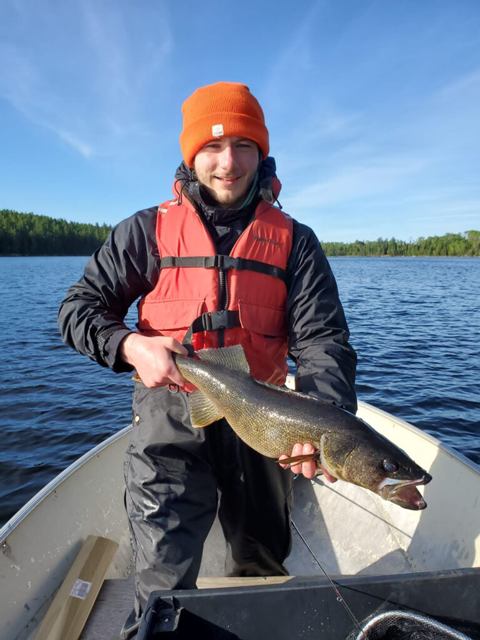 2023 Deborah Battigelli Memorial Award recipient Ben Wood. Ben is an MSc student at Lakehead investigating the impacts of spiny water flea on mercury accumulation in Walleye, with an emphasis on lakes in Quetico Provincial Park
2023 Deborah Battigelli Memorial Award recipient Ben Wood. Ben is an MSc student at Lakehead investigating the impacts of spiny water flea on mercury accumulation in Walleye, with an emphasis on lakes in Quetico Provincial Park
James Benjamin (Ben) Wood, MSc. candidate at Lakehead University, is a recipient of the 2023 Deborah Battigelli Memorial Award. Presented by the Foundation, on behalf of the Battigelli family, this Award provides financial assistance to graduate students to present their research at the annual International Rainy-Lake of the Woods Watershed Forum.
Ben's research is improving our understanding of how the invasive spiny water flea impacts the growth of walleye and also accumulation of mercury in these important fish that we love to eat.
Ben will deliver a presentation at the Forum titled "Impacts of Invasive Spiny Water Flea (Bythotrephes cederstroemi) on Mercury Accumulation in Northern Ontario Walleye".
Ben's thesis research is supervised by Dr. Michael Rennie, who heads up the Community Ecology & Energetics Lab at Lakehead University. Ben's research focusses on the impacts of invasive spiny water flea (Bythotrephes) introduced to Quetico Provincial Park and the surrounding area in the early 2000s. His research examines the relationship between the invasion of Bythotrephes and mercury bio-accumulation in walleye. Mercury bio-accumulation is the process where mercury is in low concentrations at the bottom of the food chain but reaches greater concentrations at higher levels of the food chain. In predatory fish such as walleye, high concentrations of mercury can pose health risks to both the fish, and the people or other animals that consume them causing further build-up of mercury.
To investigate if the presence of Bythotrephes has an impact on the accumulation of mercury in walleye Ben's is examining this relationship across two scales. The first investigation is a comparison on a spatial scale, comparing the size–mercury relationship of walleye within invaded lakes (with Bythotrephes) against those in non-invaded lakes (without Bythotrephes). The second investigation looks at invasion on a temporal scale, comparign historical (size-mercury) data from before the arrival of Bythotrephes to data collected after their invasion and establishment.
In addition to these two main comparisons, Ben plans to look at how Bythotrephes may be impacting walleye growth along with prey consumption and how these may be linked to mercury accumulation.
This research is of importance as mercury is a toxic metal that can pose heath risks to wildlife as well as humans, especially since walleye is one of the most consumed and sought after sportfish in Northwestern Ontario. Ben hopes his research will be able to assist policy and education regarding invasive species management as well as inform consumption advisories for walleye.
Kaela will deliver a presentation at the Forum titled "Nitrogen fixation may offset nitrogen demands in Lake of the Woods cHABs, and molecular techniques reveal species responsible for toxin production".
Kaela is part of the Aquatic Microbiology Laboratory team, studying under the supervision of Dr. Cody S. Sheik at the Large Lakes Observatory. Her dissertation research mainly focuses on how nutrients, specifically nitrogen (N) promotes and sustains cyanobacterial harmful algal blooms (cHABs) and potentially funds toxin production. She is specifically interested in a metabolic process called nitrogen fixation, which allows phytoplankton like cyanobacteria to take an inaccessible nitrogen and turn it into a bioavailable form. In doing so, the fixing organism and surrounding microbial community will have a source of nitrogen for growth and various metabolic functions.
Another large part of her research is applying a molecular approach to water quality monitoring. She is using the genetic information of the microbes, their DNA and RNA, to better understand them and what they can do. Specifically, using DNA they are able to identify and quantity microbes in the water and determine what they are capable of doing, or their “metabolic potential”. This could include identifying genes that are associated with toxin production or nutrient acquisition. Taking it a step further, they are using RNA to determine which microbes are actively transcribing for toxin production or nutrient acquisition at the time of sampling.
Kaela notes that for her dissertation research, Lake of the Woods is a compelling study lake for quantifying the effect of nitrogen-fixing cyanobacteria, as it has annual toxin producing cHABs and becomes nitrogen limited prior to the peak of the blooms. Interestingly, Aphanizomenon and Dolichospermum, two species of cyanobacteria observed in Lake of the Woods blooms, are capable of producing toxins and fixing nitrogen. Quantifying nitrogen fixation rates and using molecular tools like 16S rRNA amplicon sequencing, she's hoping to understand how cyanobacteria that are able to create their own nitrogen play a role in blooms on Lake of the Woods and their associated toxin production. Kaela believes that understanding how nitrogen contributes to cHABs and possibly toxin production and identifying the cyanobacteria responsible for toxin production could better inform management of the ecology and nutrient demands of blooms in Lake of the Woods.
To honour the memory of Deborah Battigelli, her family established The Deborah Battigelli Memorial Fund at the Lake of the Woods Water Sustainability Foundation. The Fund honours Deborah’s love of life at the lake and her interest to preserve the lake area for future generations to continue to enjoy what she loved. The purpose is to assist the up-and-coming generation of scientists with their research on our lakes to ensure future capacity for protecting the water quality and ecological health of our lake area for generations to come. For more information about the Deborah Battigelli Memorial Fund or to contribute visit: www.lowwsf.com/battigelli-fund.
